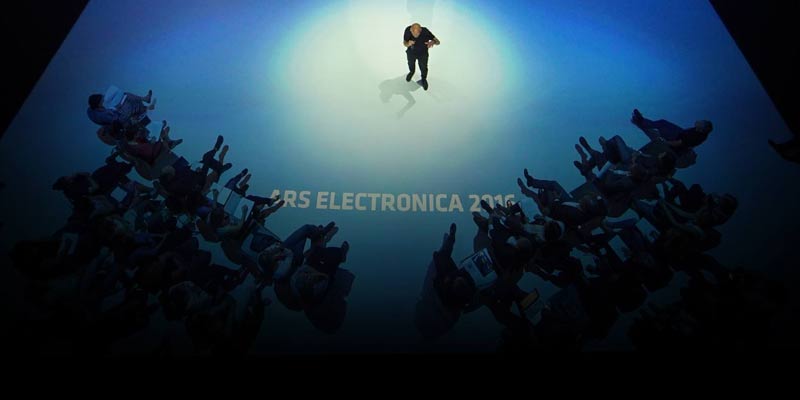Ars Electronica Center and Linz Art University present:
New Exhibition: TIME OUT .05
Press release: “New Exhibition: TIME OUT.05” / PDF
Ars Electronica Blog: Interviews with the artists
(Linz, March 16, 2016) The 5th TIME OUT exhibition staged jointly by Linz Art University’s Time-based and Interactive Media program and the Ars Electronica Center once again features works by up-and-coming young media artists. “The exhibition series launched in January 2014 splendidly complements our curriculum by giving students a chance to present their work to the general public in an extramural setting,” noted Prof. Gerhard Funk, the director of the program. “And since our department is celebrating its 10th anniversary in 2016, we decided to expand the two TIME OUT shows we’re presenting this year.” Ars Electronica Artistic Director Gerfried Stocker is delighted with the latest collaborative venture with Linz Art University: “A real-time analysis of the blind spots of Austrian online journalism, an interactive work addressing the vagueness of our communication, and a home-brew 3-D printing process for ceramics—time and again, I’m absolutely fascinated by what Linz media art undergrads are into!”
TIME OUT .05 – The Projects
[inter]national coverage (2015) / Benedikt Reiter
In “[inter]national coverage,” Benedikt Reiter shows which regions and countries are currently making headlines in Austria-based online media and which aren’t. To do it, data from the previous 24 hours are evaluated and projected onto a relief-type map of the Earth. This makes it apparent at first glance which areas of the world are considered newsworthy by Austrian and Western media outlets and which ones create minimal blips on these journalists’ radar screens.
Gitterlinge (2015) / Thomas Schwarz (AT)
Thomas Schwarz invested months of work in the development of ceramic pour printing, a new 3-D printing process in which water-soluble filament is formed into a mold that, in turn, is used to cast the final object. Thus, the actual design is captured in the form of a shaped cavity into which fluid ceramic material is then poured. As a final step, the entire casting is immersed in boiling water to dissolve the mold. This ceramic pour printing process combines the manifold possibilities of 3-D printing with tried-and-true traditional ceramic casting methods to provide interesting new options for the production of complex 3-D ceramic objects. The first series of designs the artist developed using this method is entitled “Gitterlinge,” more than 20 filigree three-dimensional ceramic sculptures consisting of pillar structures.
Unreadable (2015) / Elisabeth Prast
In “Unreadable,” the text on the monitor remains illegible regardless of how near the prospective reader gets to the screen. If you’re too far away, you can’t make out the writing; when you come closer to the monitor, the letters start to deform and become blurred; and as soon as you take a few steps back again, the words return to their original form. And even if the reader does succeed in deciphering the displayed message, all that he/she discovers is the familiar filler text beginning with the words Lorem ipsum. “Unreadable” is Elisabeth Prast’s take on the immanent vagueness of our language and communication, which constantly leads to misunderstandings.
Plug-It (2015) / Fabian Erblehner
“Plug-It” is a sound installation in which visitors amidst a hanging garden of cables can easily create their own soundscape. The installation consists of 50 hanging cables and five loudspeakers. The cables are assigned to 10 previously recorded sounds; thus, for each sound, there are five available cables, which can be hooked up to the loudspeakers however the visitor likes.
Siblings of Frank (2014) / Andreas Trixl
All of us have long since gotten used to the fact that in practically every store we enter and, increasingly, every public square we walk through, surveillance cameras record every step we take. But establishing direct eye contact with the lenses that are keeping an eye on us brings forth a rather uneasy feeling. With the help of a Kinect camera and OpenTSPS software, “Siblings of Frank” recognizes persons and objects in the installation space and reports their position to a program that controls the movements of the artificial eyes projected onto the space’s wall. Which eye focuses in which direction is allocated at random. If they don’t recognize anything, they close their artificial eyelids.
Your Unerasable Text (2011-2012) / Stefan Tiefengraber
“Your Unerasable Text” is an interactive installation that asks how and when digitized data can ever be permanently deleted. The work consists of an unadorned pedestal with a commercially available printer positioned on top of it. And right below the printer, there’s a file shredder. Exhibition visitors or passers-by are called upon to use their cell phone to send an SMS (with any content they wish) to a particular telephone number. This SMS is sent to the installation’s computer, which forwards it to the above-mentioned printer that prints it out in DIN A6 format. The print-out then falls into the file shredder where, after a brief moment of hesitation, it’s cut to ribbons. All that’s left are thin paper strips that fall to the floor and add to an ever-growing pile of shreds. So, it would seem that the message has been destroyed, were it not for the many digital copies that had been created and stored each step of the way from phone to phone to computer to printer, and can now be re-accessed at any time.
http://www.flickr.com/photos/arselectronica/25202574843/
Gitterlinge / Martin Hieslmair / Printversion / Album
http://www.flickr.com/photos/arselectronica/25708230592/
international coverage/ Martin Hieslmair/ Printversion / Album
http://www.flickr.com/photos/arselectronica/25803124316/
Unreadable / Martin Hieslmair/ Printversion / Album

